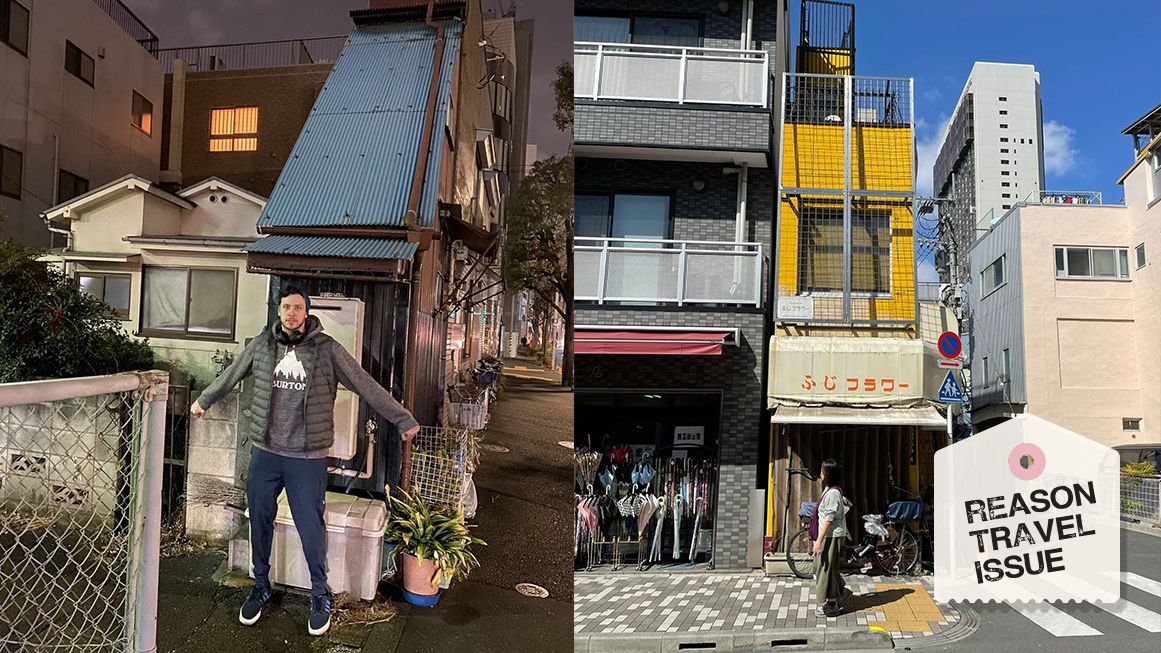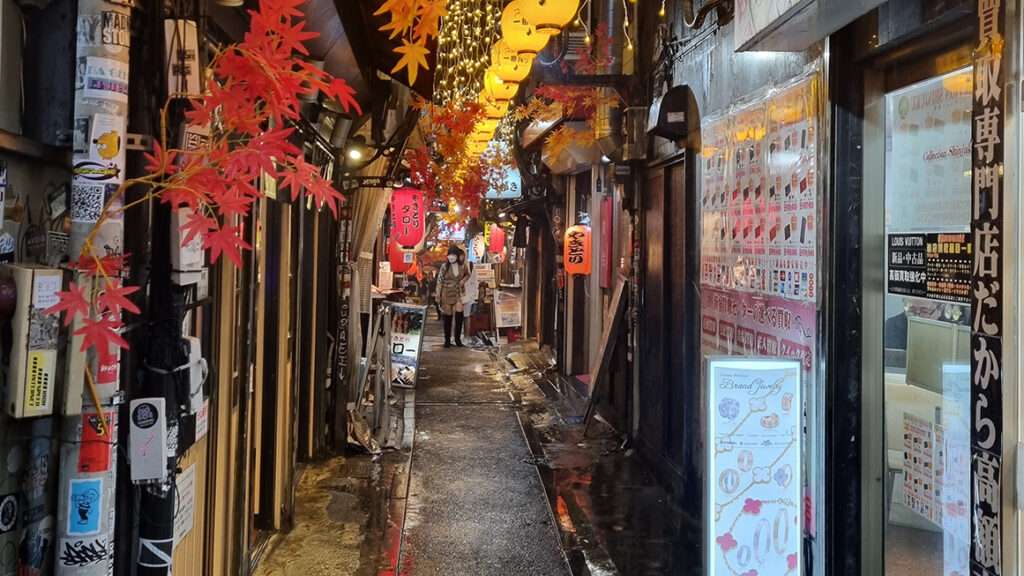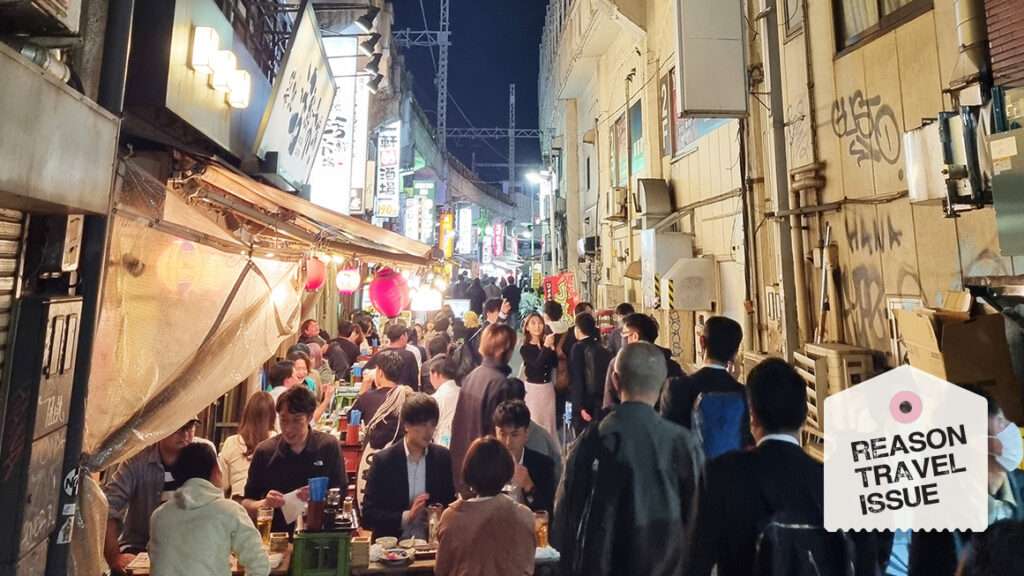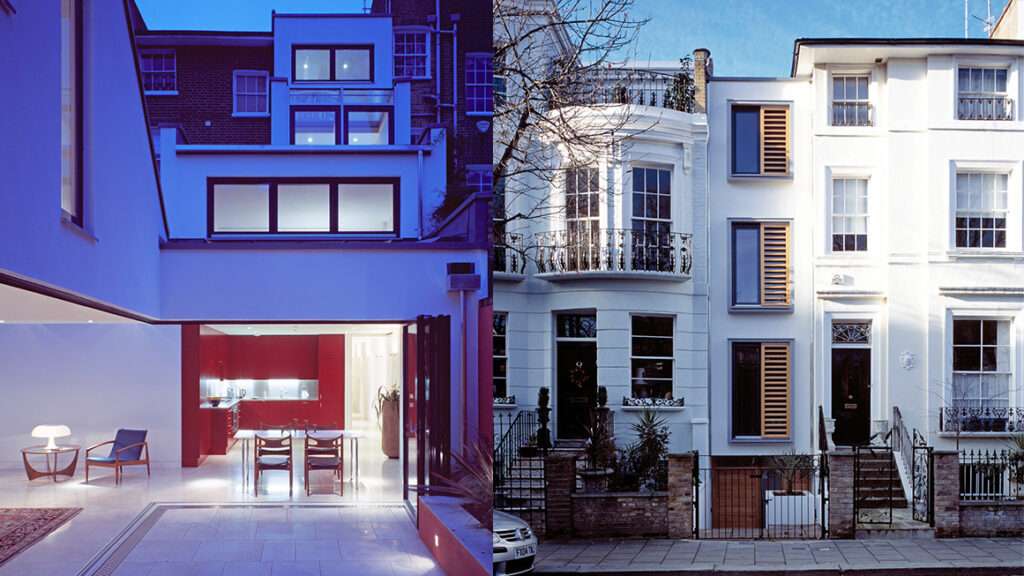Capitalism in the Cracks: How Japan's Microspaces Unleash Economic Experimentation
These spaces are so small that most cities would ignore them. Tokyo doesn't.

This is part of Reason's 2025 summer travel issue. Click here to read the rest of the issue.
A three-story house tucked into a mere one-meter gap between tall buildings. A flower shop shaped like a triangle, wedged between a retaining wall and the sidewalk. A standing bar humming with laughter beneath the rumble of passing trains. In most cities, these spaces would be dead zones—awkward, overlooked, written off by zoning and building codes as unusable.
But in Tokyo, they bloom with life. These microspaces are amenities. They're capitalism in the cracks, not just in form but in function.
These strange slivers often become homes for new ideas: a two-person bar, a bookstore barely wider than a fridge, a late-night shop that opens on a whim. They invite experimentation, economic as well as architectural.
Tokyo's ability to cultivate these spaces isn't just a cultural quirk. It's a byproduct of a city that leaves room for improvisation, that adapts to its imperfections, and that transforms constraints into creativity. These spaces reveal what is possible when cities loosen their grip on regulations—when policy becomes an enabler, not a gatekeeper. They offer a glimpse of what urban life could look like if more places embraced flexibility.
Tokyo's urbanism emerged more than it was planned. Most of its neighborhoods weren't drafted in a planner's office. They were shaped incrementally by individuals responding to need and opportunity.
Modern Tokyo is a city born from ruin. After the devastating bombings of World War II, with little funding available for formal reconstruction, residents rebuilt on their own—using salvaged materials to create homes on the ruins of old neighborhoods. Over time, the government stepped in to connect and formalize what had already taken shape. The result is a dense, oddly beautiful patchwork: irregular lots, winding streets, and spaces so small that most cities would ignore them. But Tokyo doesn't.
There are at least three varieties of microspaces here: pet architecture, yokochos, and undertrack infills.
***
Of all of Tokyo's urban quirks, few are as endearing—or revealing—as pet architecture.
Coined by the architectural firm Atelier Bow-Wow, the term describes buildings that are "unusually small, humorous, and charming": little pets in a city built for human beings. Awkwardly shaped and impossibly tiny, they defy conventional notions about how much space is necessary for any given use.
You might stumble upon a rubber stamp store crammed into a leftover triangle of land between a train line and the road in Nakano. A one-meter-wide real estate office in Shimokitazawa. A tiny bakery that somehow fits between a wall and a utility pole in Koenji. These are buildings that shouldn't exist, but they do.
In many cities, spaces like these would be rejected outright as unusable. They'd run into a wall of regulatory barriers: minimum lot sizes, minimum unit sizes, parking mandates, and zoning codes that separate uses into rigid slots—residential here, commercial there, industrial somewhere else.

But in Tokyo, they're opportunities. They challenge bureaucratic assumptions about what buildings are supposed to look like. As the Atelier Bow-Wow architect Yoshiharu Tsukamoto has put it: "They illustrate unique ideas with elements of fun, without yielding to unfavorable conditions." Pet architecture is playful, it's resourceful, and it's all over the city.
***
Yokocho literally means "side street" or "alleyway." In Japan, it means something more: narrow lanes filled with tiny bars and restaurants. Usually found near train stations or commercial centers, these narrow streets range from just 1.3 to 2.8 meters wide—narrow enough to stretch out your arms and touch both walls, too tight to meet code in most U.S. cities. Inside, you'll find bars the size of walk-in closets, seating six to 12 patrons and often run by a single staffer.
Yokochos emerged after World War II as black markets. They were improvised stalls selling basic goods. Over time these stalls became food joints and drinking dens, and eventually they were fixtures of Tokyo's urban landscape.
The Golden Gai district in Shinjuku packs more than 200 tiny bars into six alleyways in an area smaller than a city block. (It's the kind of setup a North American fire marshal would never allow.) Most buildings are two stories high, with steep staircases leading to completely different experiences upstairs. Want a fancy whiskey bar? It's there. A horror movie–themed bar? Absolutely. Hospital-themed? Erotic fetish? Retro video games? A quiet library bar? They have all of the above. All unique. All impossibly small.
Nearby, on the other side of Shinjuku station, the Omoide Yokocho district is known for late-night yakitori (chicken skewers) and drinks, with around 80 shops squeezed into a single alleyway. In Shibuya, Nonbei Yokocho—or "Drunkard's Alley"—crams 40 shops into spaces barely two meters wide. And in Ebisu, Ebisu Yokocho sits in a covered passageway built on the remnants of a former shopping center that houses izakayas (Japanese pubs) ranging from 10 to 16.5 square meters, serving everything from grilled fish to okonomiyaki to oden.
So beloved are these places that developers have recreated them inside modern buildings. Shibuya Yokocho, a sleek version inside the Miyashita Park complex, mimics the feel of the real thing, with curated chaos, shared tables, and dishes from every prefecture in Japan.
Nostalgia aside, yokochos are more than relics. Their size, affordability, and independence make them incubators for creativity and entrepreneurship.
***
Tokyo's rail system is everywhere—and wherever there are train tracks, there are gaps. In many cities, these would be fenced off. In Tokyo, they're filled with life.
Like yokochos, many undertrack infills began as black markets after the war. What were once dusty, makeshift stalls have since evolved into hubs of commerce and dining.
Near Ueno Station, izakayas nestle underneath and between train lines. You can sit shoulder-to-shoulder with salarymen, sip a highball, nibble on sashimi, and watch the trains pass overhead.
A few blocks from there is Ameyoko, a market wedged beneath the Yamanote Line between the Okachimachi and Ueno stations. It's a sensory overload: cosmetics, spices, fresh seafood, and cheap street snacks packed into a narrow pulsing corridor under the tracks.
A few stops away on the Yamanote Line, in Yurakucho, rows of cozy restaurants and standing bars are tucked into the arches beneath the tracks. Some are linked by narrow alleyways that run under the railway itself, connecting one lively pocket to another. At around 6 p.m., the lights come on, the smoke rises, and the area fills with after-work revelers grabbing food and drinks before catching their train home.
What unites these undertrack infills is their uncanny ability to turn infrastructure into opportunity. Instead of ignoring the voids created by transit, Tokyo builds into them.
***
To understand why Tokyo looks the way it does, you have to start with zoning. Zoning laws determine what can be built and where—homes, shops, factories, or nothing at all.
In the U.S., zoning is local. Each city or county writes its own code, but most follow similar templates. Neighborhoods are typically residential, commercial, or industrial, with little room for overlap. The rules are rigid. It's often illegal to run a small business out of your home or to build on a lot deemed too small. Any change of use typically requires hearings, permits, consultants, and months—maybe years—of paperwork. It's a large bureaucratic system that tends to push out small, experimental, or unconventional uses.
Japan takes a different approach. The same zoning system applies nationwide, from Tokyo's densest neighborhoods to the smallest rural town. The rules are meant to maintain the scale of buildings, preserve sunlight access, and prevent fire hazards.

Instead of rigid land-use rules, Japan uses a set of 12 flexible zoning categories, arranged on a spectrum from residential to commercial to industrial. These are broad guidelines, not strict prescriptions. Within them, landowners are largely free to decide how to use their space.
Take Category 1, officially designated as "exclusively residential." In practice, that doesn't mean only homes can be built. Small shops, dental clinics, hair salons, and day cares are all permitted. What's prohibited are large, disruptive developments. You won't find a department store in Category 1, but you might find a ramen shop on the ground floor of someone's home.
Each zone builds on the one before it. If something is allowed in Category 1, it's automatically allowed in Categories 2 through 12. The only major exception is strictly industrial areas. Elsewhere, layers of possibilities build on each other, allowing for the kind of vibrant, fine-grained mixing of activities you see in Tokyo.
Japan also avoids rules that would make small-scale development impossible. There are no minimum lot sizes. Small parcels can be freely subdivided. Building heights are based on road width, not a fixed number. And it's legal to run a business out of your house. The result is a city that allows for increasingly complex and nuanced configurations.
The rules are more like scaffolding than a straitjacket. They set the frame, but decisions are left to property owners, architects, and builders.
This flexibility has made Tokyo radically adaptable. It makes space not just for small businesses but even smaller microbusinesses. If you have an idea and a few square feet, you can start something without hearings or expensive consultants.
"There are a lot of ways in which not only zoning but other pieces of the puzzle all come together to encourage these experimental, intimate, small-scale mom-and-pop businesses," explains Joe McReynolds, an urban studies scholar at Keio University's Almazán Architecture and Urban Studies Laboratory. "There's a lot of tilt in the regulations toward small businesses," he says, from lower taxes and simpler food safety rules to the relative ease of getting a liquor license.

Tokyo may be unique, but you can sometimes spot a glimmer of flexibility even in cities with heavy-handed planning systems.
Take London. With its heritage protections, conservation zones, strict building codes, and endless red tape, changing the built environment there often means running an obstacle course of applications, consultations, and design reviews. Yet small-scale invention sometimes slips through.
In West London's Bayswater conservation area, where uniform facades and historical preservation rules are the norm, you'll find the Gap House. With a street frontage of only 2.3 meters (8 feet), this five-story home fills what was once a narrow alley between two buildings.
"My inspiration was Japan and the Netherlands," explains the architect (and owner), Luke Tozer. "Both make good use of small bits of land."
The project required extensive negotiation, creative diplomacy, and imaginative design work to bring neighbors and planners on board. "We ultimately convinced them of a design that could be contemporary and sympathetic to the adjoining areas without it trying to mimic them," Tozer says. "One of our arguments was [that] it should be different because it's obviously of its time but also we want to try and still make it clear that it is a gap."
The result is a home that opens into a rear garden and maximizes every inch of its narrow footprint. "It required some imagination. Thinking out of the box. Good design, that's where it comes in," Tozer reflects. "That's where good design adds value on tricky sites."
The Gap House shows that even in cities bound by strict zoning and preservation overlays, there's still room for architectural courage.
"I love the fact that in a city—even a city where you've got an acute housing crisis like in London—there are always bits of land that are left over, forgotten," Tozer says.
There are cracks worth filling. But if every project demands a fight, we will never see this kind of development flourishing.
"Letting people run a little coffee shop, a little bookstore out of the ground floor of their houses, that's the sort of thing that makes a neighborhood charming and local and lovable and livable," McReynolds says.
That's part of what makes Tokyo so magnetic. It's a city where the unexpected flourishes. Walk a single block and you'll see a narrow home tucked between buildings, a pet-sized owl café, or a triangle-shaped standing bar. It's this patchwork—this mixture of building scales and uses—that gives the city its pulse.
Tokyo can't be copied. Its history is unique. But we can learn from its ethos of trusting its citizens and adopting policies that enable rather than restrict. If more cities embraced the idea that flexibility breeds vitality, we might start to see cracks of our own—cracks that could be filled with opportunities.
This article originally appeared in print under the headline "Capitalism in the Cracks."
Editor's Note: As of February 29, 2024, commenting privileges on reason.com posts are limited to Reason Plus subscribers. Past commenters are grandfathered in for a temporary period. Subscribe here to preserve your ability to comment. Your Reason Plus subscription also gives you an ad-free version of reason.com, along with full access to the digital edition and archives of Reason magazine. We request that comments be civil and on-topic. We do not moderate or assume any responsibility for comments, which are owned by the readers who post them. Comments do not represent the views of reason.com or Reason Foundation. We reserve the right to delete any comment and ban commenters for any reason at any time. Comments may only be edited within 5 minutes of posting. Report abuses.
Please to post comments




The bathrooms stalls at the Narita international airport in Tokyo are tiny. They have a warning to not stand on the toilet seat (while dumping). For those that don’t read Japanese, Korean, Mandarin, or English there is a pictogram with a red circle and single slash.
"They have a warning to not stand on the toilet seat (while dumping)."
Kinda euphemistic, and possibly misspelled. Did you mean "while Trumping"?
Holy Shiites, just this morning I made a Trump SOOOO large, I thought that maybe I should spank shit, to see if shit breathed, and if shit did, then put a diaper on shit, put shit in a box, and drop shit off at the front door of the orphanage!
Unread
Ass I understand shit, when Dear Deep-Orange-Socialist Leader Himself visits over-crowded, cramped Japan on snot-so-very-diplomatic visits, and Dear Leader Himself (AKA Fat-Ass Donnie-Boy) has to make a Mini/Maxi-Trump, the Japanese have to clear out some adjacent tiny-houses (shops etc.) just to build Him a suitably mammoth-sized bathroom!
Unread
The grey box would allow someone to stand above him and take a dump directly into his mouth using a chair, bench, or stool.
I'm not sure which state his mental hospital is located in, but he should ask his guardian to check with the personalized license plate registrar at the local DMV to see if SCATMAN is available. It'll make the weekly rides to the petting zoo that much more enjoyable.
He likes to visit the monkeys. When they fling poop at him, he gets a free snack.
"Mentally ill" or “insane”, my ass! Whoever disagrees with totalitarians is "mentally ill"! That makes YOU just like the communist totalitarian assholes of the USSR who used psychiatry to punish political dissidents, asshole!
Sure… All of those who disagree with MEEEE are… Mentally ILL!!! YES, this! Good authoritarians KNOW this already!
https://en.wikipedia.org/wiki/Political_abuse_of_psychiatry_in_the_Soviet_Union
All of the GOOD totalitarians KNOW that those who oppose totalitarianism are mentally ill, for sure!!!
Totalitarians do things by definition, these definitions handed down by authority and executed ad baculum. Experimentation is only allowed when new weapons are needed to add more baculum--or to preserve any baculum already inserted into formerly free trade.
Speaking of definitions, please tell us what a woman is.
Speaking of totalitarians, tell us again how people who refuse the Covid shot should be fired, Hank.
The totalitarians are the ones who think that they (or the voters, or Government Almighty), and SNOT the owners of businesses, should be making the hiring and firing decisions! Right, Marxist Death-and-Suicide-Lusting Moose-Mammary Necrophiliac?
And plate the toilet with gold!
It's so easy to see the difference between what is allowed v what is prohibited. Here in the US, many areas zoned for commercial are empty buildings surrounded by empty parking lots. They can't get a new business in that building because the location has proven it can't support a business. The building can't be repurposed because every new purpose would require the parking and other minimums. So the property slowly decays waiting for a BIG redevelopment on multiple lots requiring rezoning and eminent domain.
The most pervasive examples are the big box malls.
One of the fanciest shopping malls in the US was White Flint, in Montgomery County, MD. It closed in 2015. It has been replaced with a mixed residential and commercial development including 2,500 residential units.
One of the many great things about New York City that drives MAGA people into seizures because they can't imagine that NYC actually has LESS regulation for some things than their red states is that in most of the residentially zoned areas in the city the zoning allows for businesses. Most home occupations that aren't retail are permitted basically everywhere (and I have had a home based side gig for 24 years). In most of the city, lower floors of rowhouses and apartment buildings can be retail establishments or larger offices. I can't imagine NYC being any other way.
We still need to allow much higher density.
Uh, sure.
I wish you a happy Blade Runner style life. But please never leave NYC.
*NYC actually has LESS regulation for some things than their red states*
"Some" is doing a lot of heavy lifting in that sentence. It does indeed have less in certain areas, coupled with oppressive regulation in other areas. How's it doing on housing, school choice, taxes, crime, etc?
NY fails to pass the low regulation test for the same reason most deep red states and all deep blue states do: One-party states are hopelessly corrupt. They confiscate your rights and sell them back to the highest bidder. You're far better off in a state or city where each party can lose power in any given election. Sadly, there are fewer and fewer of those remaining.
Yeah! They have no regulations on shitting in the street, shooting up fentanal, giving puberty blockers to kids...
“in most of the residentially zoned areas in the city the zoning allows for businesses. Most home occupations that aren't retail are permitted basically everywhere”
Tell me you know nothing about how zoning in most states work without telling me you know nothing.
they can't imagine that NYC actually has LESS regulation for some things than their red states
All the late term abortions and child sex changes you could dream of, but don't think about opening a babershop without a two year, $30,000 course.
This is what poor people do to survive.
That, or tugging off truckers under the turnpike. Either way, they're pulling for a happy ending.
The zoning ordinances may be local, but the building codes , fire codes, and life safety codes generally are not. They also have minimum sizes for habitable interior spaces, egress and setback requirements, etc.
While most zoning is about inflating the value of the property of those lucky enough to have bought in the past, building and fire codes actually matter. 17 people died in this apartment fire 3 1/2 years ago and a major contributor to the deaths. Inadequate heat, space heaters, and malfunctioning fire doors, all violations of building or fire codes. And the building had been exempted from codes in order to promote affordable housing.
https://en.wikipedia.org/wiki/2022_Bronx_apartment_fire
I visited the site two days later. It looked like something that had been bombed out in a war zone.
Space heaters are not violations of building or fire codes in any jurisdiction that I've worked in.
Meh. Or even yech.
Looking out my window I see part of a 1700 square mile county with about 60,000 people, an average density of 35 people per square mile. I can travel less than a hour and have a square mile to myself. Even in town the density is less than 1300 people per square mile, or 2 people per acre. No need to live, or socialize, in a phone booth.
I'm guessing that is the most common preference amongst anyone who leans libertarian. I know it's mine.
I think Japan is fascinating, and I enjoyed going into a couple of these places while I was there. But that doesn't mean I want your big city quirkiness in my suburb. Keep your s'mores out of my beer and your high density out of my town and we'll get along just fine.
I agree with your guess about libertarian personality preference.
More than preference, I have pondered how population size necessarily challenges autonomy. I do accept that we each need to constrain our own behavior in some ways to be part of a community, and have different preferences for those trade-offs. I then wonder how those trade-offs increase as does population.
If personal autonomy trade-offs, including through law and regulation, depend on the number of potential interactions between individuals, then simple math shows the number as a factorial function of the population.
For 2 people, there is only one possible interaction. For more than 2, there are interactions that are one-on-one and also among larger groups. Here are the potential interactions for increasing populations:
3 people: 3 one-on-one, 4 total
4 people: 6 one-on-one, 11 total
5 people: 10 one-on-one, 26 total
6 people: 15 one-on-one, 57 total
7 people: 21 one-on-one, 120 total
8 people: 28 one-on-one, 247 total
9 people: 36 one-on-one, 502 total
10 people: 45 one-on-one, 1013 total
15 people: 105 one-on-one, 32,752 total
20 people: 190 one-on-one, 1 million total
30 people: 435 one-on-one, 1 billion total
50 people: 1225 one-on-one, 1 quadrillion total
100 people: 4950 one-on-one, 1 nonillion total
500 people: 124,750 one-on-one
1000 people: 499,500 one-on-one
5000 people: 12 million one-on-one
10,000 people: 50 million one-on-one
100,000 people: 5 billion one-on-one
1,000,000 people: 500 billion one-on-one
So even if there is only a loose connection between the number of people, and who they interact with, and what some of them then expect in managing society, the math looks bad for libertarians with large (and dense) populations.
Reason disagrees where large, dense, urban populations provides good prospects for being able to attend bespoke cocktail parties. Of course, libertarianism itself would not be tolerated in such circles beyond occasional and tangential acceptance as “edgy.”
I absolutely believe density breeds regulation HERE. Pretty obvious patterns arise in comparing cities vs rural locations across the US, regardless of the larger state politics. Not sure how you would have to rethink this idea to include high density populations in Central / South America, Asia or Africa, which are frequently so low in regulation as to border on anarchy.
No American would ever accept living in a closet long term outside of perhaps New York, which notably has more than double the population per kilometer and still manages to have larger apartments than Tokyo.
Maybe there's a reason Japan has a forest where tons of people go to kill themselves while New York (and America generally) does not.
I actually live next to a forest preserve that is a popular suicide destination, but, yeah, that's unusual here.
Japan is currently getting the globalist migrant treatment from what I've been reading. But luckily they are standing up to it much sooner before it gets out of hand for them. good for the japanese.
The result is a dense, oddly beautiful patchwork: irregular lots, winding streets, and spaces so small that most cities would ignore them. But Tokyo doesn't.
That's not beautiful. That's dumb. That's the mentality of a hoarder shoving everything they possibly can into every nook and cranny, instead of just stepping back, cleaning up, and getting organized.
You know what's fascinating about Western/Middle America compared to the East Coast? Most of the time you can see the mentality behind the cities at work. East Coast, it's just total sprawl. They were colonial cities that just kept expanding and expanding. They had to work their way around natural obstacles that were impassable at the time, they had to adapt to rapidly growing populations, etc. etc. Look at them from the sky, and it's a mess.
Compare that to a place like Lexington or Oklahoma City or Phoenix and what do you see? Grids. Continuous streets that traverse the city. Beltways that surround it with highways that run N-S and E-W through the cities. Space reserved for expansion.
You think there's some kind of cute charm to a few million people all shoved into a tiny disorganized space trying to eek out life in some pesthole they've carved out for themselves? There's not.
Far better are cities where their people had foresight and ideas beyond their own immediate need. Far better are cities designed by people who envisioned 1st World Comfort over shoving as many bodies into pods as possible.
Every article this site publishes on this subject is disgusting. Each and every one of them stinks - flat out reeks - of human filth all shoved together reciting a monotone NPC chorus of "We will have nothing and we will be happy."
Go to hell.
they defy conventional notions about how much space is necessary for any given use.
Yea yea, you will live in the pod, you will eat the bugs.
Shut up.
They challenge bureaucratic assumptions about what buildings are supposed to look like.
More social/cultural marxism nonsense.
Irony Man praises central planning and calls the alternative Marxist.
Y'know, when you build something - from a Lego set to your Ikea garbage to a house to a city - it's wise to use a blueprint.
That doesn't make it central planning. Idiot.
Centrally planned cities are not centrally planned. Got it.
There's a difference between 'central' planning, and 'planning'.
But, to engage with AT's point, Eastern cities were largely developed before the widespread introduction of the automobile as a consideration, and Western cities were generally developed afterwards. So when you're in St. Louis and points East of that, you generally have some curvy roads, and it looks more 'organic' (or 'messy'). If you're in Kansas City and points West of that, you find a lot of cities with streets laid out as orthogonal grids.
Same concept applies when you look at town / street layouts in Europe, Mexico, etc.
I'm aware of this. I was thinking more about zoning. Not a fan. With few exceptions, like putting a pig farm in the center of town for example, I think people should be able to do what they want with their own property. What's wrong with a coffee shop in a residential neighborhood?
“What's wrong with a coffee shop in a residential neighborhood?”
Traffic and parking are the main issues, but these can be solved in myriad ways as many older neighborhoods have done.
Sarcles might warm to the idea of a drive-thru liquor store in a residential neighborhood.
Like he can afford a car.
Sarcasmic is trolling. No amount of logic will convince him because he's here to troll and shitpost.
He’d settle for a Colt 45 vending machine that accepts EBT cards for payment located in the alley where he keeps his cardboard box house.
Ah, resort life.
I don't really see any problem with a small business in a residential neighborhood - some of the logistical concerns that Nate brought up are fairly easy to deal with, as he pointed out. And, I'm not a big fan of zoning in particular anyway, with the caveat that I do think it makes sense to ease the transition from one sort of use to another - i.e. not putting a bomb factory next to a daycare, etc.
Fair.
“And, I'm not a big fan of zoning in particular anyway, with the caveat that I do think it makes sense to ease the transition from one sort of use to another”
Exactly this.
The logistical aren't the only concerns though. Y'know, I saw a gobsmacking video the other day:
https://x.com/WallStreetApes/status/1959291222435983583
That's what happens when you have no/unenforced rules in society. Literally, at the foot of the shining jewel of their entire nation. Zoning may be frustrating, but it DOES have a legitimate purpose - consented to by the people - who do not want their parks and roads and neighborhoods turned into mobile flea markets and open-air bazaars the likes of which are seen on the dirt roads of Mogadishu.
This is why I always criticize this site - and a lot of the people on it - when they claim to be "libertarians." Because they're not. They're leftists/anarchists. They want all the finer things found in a first world society, but none of the social/cultural rules that allow those finer things to exist. Like a cognitive dissonance that simultaneously tells them, "I like the fruits of the social contract" and "I want to break the social contract whenever I want."
Altruist Totalitarian would to go somewhere else, but his superiors at the DEA assigned him to libertarian monitoring. That's what happens to narcs who can't pass the test of distinguishing a bouillon cube from a gram of hashish.
Cite?
how can you leave out the price per square foot (or meter) versus other places
Libertopia will be an island nation, too.
Tokyo can't be copied. Its history is unique. But we can learn from its ethos of trusting its citizens and adopting policies that enable rather than restrict. If more cities embraced the idea that flexibility breeds vitality, we might start to see cracks of our own—cracks that could be filled with opportunities
A lot of what you're trying to talk about here requires an incredibly high trust society. Japan has that, we don't.
This
Maybe high trust but also a hive mind, or at least minimal personal expectations.
Homogeny will do that, but as a certain radical chemist tells us, fuck you for suggesting that (unless he said to do that, see gun culture).
He’d show up there demanding someone put a tranny groomer buttfuck palace next to an elementary school and they’d compliment him on his Godzilla costume.
You nailed it.
The US used to be a high-trust society. I won(D)er what happened.
^BINGO..... +1000000000
Christians were forced to bake the cake and ENB refused to make the sammich.
Just make the hoagie, lie back and think of England.
Much of it still is. Urban people who live in low-trust subcultures have no idea how much that costs them. Low trust makes everything you do more difficult. People in those subcultures tend to attribute the extra difficulty in their lives to racism, but, really, it's how they treat each other that burdens them.
Doesn't help that there is an entire culture, I mean cult, around our president that demonizes anyone who isn't a sycophant as well as anyone with a foreign accent. Coworkers, neighbors and family are all enemies if they don't worship the president and don't hate foreigners. That's no way to build trust. Quite the opposite.
It sure as heck is a good recipe for enlisting enemies and breeding resentment. With the 1971 Nixon law still using the IRS to subsidize looter party campaigns (worldwide), simmering resentment can only hiss louder in the pressure cooker. TRUE FACT: Venezuela was the first country where Nixon's limo was pelted with brickbats!
Sad
https://maineaa.org/
Man, what is going on in Maine? I travel around Texas remodeling gas stations and I’m just not seeing the kind of animosity you’re describing (most of the gas station owners aren’t exactly native and I don’t think I’ve ever seen a red hat, let alone heard locals disparaging them. Although, come to think of it, most of those owners voted Trump because he’s a businessman and wasn’t talking about wealth and capital gains taxes.)
In the People’s Republic of Portland, Maine they’ll have their kids key your car if it has a Trump or Maga sticker. Most of the land within the borders is red.
When was this? Also you aren’t even American so how the fuck would you know?
Xenophobe
Wonder if they do health inspections of the tiny restaurants or bars. If not, that shows a higher level of trust by the citizenry.
In so many ways US "land of the free" is a joke anymore since the [Na]tional So[zi]alist[s] started winning and violating the US Constitution.
You voted for our National Socialist president. Three times. And you'll vote for him again if he runs for a third term. Because you don't give two shits about the Constitution. You only care about having a strongman in power who will wield guvguns against people you hate.
Did TJ do that? Are you sure?
I voted for him just the last time because Kamala Harris was so terrible, but I wouldn't vote for him again in 2028 because I can't image that he'll even try to run. If he did, I still wouldn't.
Seems like a lot of wishcasting and projection here, honestly.
If TJ's brain was replaced with a peanut it would be an improvement.
Poor sarc.
I voted for Trump because he does Tax-Cuts, De-Regulation and Abolishes UN-Constitutional agencies/taxes/laws.
Who did you vote for sarc? A proud Democrat/ic Socialist who wants to "centrally plan" everything and do more "wealth distribution" and [WE] Identify-as *special* entitlements?
Trump hiked taxes massively you pathetic fool. And the last time I voted was for Gary’s Johnson. Ever since the GOP nominated a game show host I lost interest in voting.
Trump hiked Tariffs. He Cut-Taxes (twice now) you pathetic fool.
Noticed how you just blatantly ignored all those other points.
Gary was a good pick and Trump isn't the socialist you pretend he is just because your 'imports' now have a tax. If you really cared you'd be pushing for spending-cuts; which Trump also is/did.
"Yokochos emerged after World War II as black markets." Since Ms Hall twice mentioned WW2, it is only fair to note that Japan, horrified at the narcotic addiction spreading across Asia, copied the Dutch project of instead cultivating a non-addictive stimulant on Taiwan. Eastern cocaine also brought revenue after earthquakes. Pugilist Jack Johnson defeated a white boxer after Teedy Roosevelt demanded white women be forced to reproduce otherwise "race suicide." "Cocaine negro" rumors sufficed to pass the Harrison Act, and additional laws banned movies showing Johnson defeating honkies. Japan balked, quit the League of Drug Cartel Nations and was regarded as "uppity" and shunned by dry prohibitionists. In 1906, Interior Sec'y Ethan Allen Hitchcock of Alabama expected "that war with Japan is inevitable before the Panama Canal is finished." His timing was off...
Needs more Comstock.
What about Comstock?